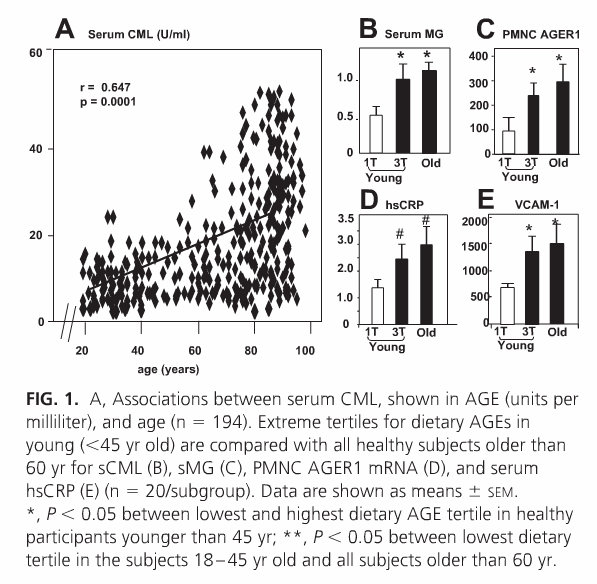Diet can both cause and mitigate inflammation. The general dietary guidelines outlined here ensure that you get sufficient amounts of vitamins, minerals, and other antioxidants from your diet. That takes care of the anti-inflammatory part of the equation.
On this page, I want to talk about the things in your diet that are likely to cause inflammation. Studies have shown that minimizing these will reduce inflammation, and, therefore, should be helpful in acne.
Advanced glycation end products (AGE)
Advanced glycation end products (AGE) are compounds that form when proteins or fats combine with sugars, as a result of glycation. AGE are also known as glycotoxins. From Wikipedia: “These harmful compounds can affect nearly every type of cell and molecule in the body and are thought to be one factor in aging and in some age-related chronic diseases.”
AGE are formed when fat- or protein-rich foods are cooked at high temperatures. Cooking methods that create the most AGE include frying, BBQing, roasting, etc. In contrast, water-based cooking methods (like steaming, boiling, poaching) produce much fewer AGE. Please see the page about AGE in the diet section for more.
Several studies have linked dietary AGE into inflammation. To date, 9 studies have examined the difference between high and low AGE diets. Out of those, 8 showed that low AGE diets reduced inflammation and/or insulin resistance.
In 2009, researchers from Mount Sinai School of Medicine in New York published an interesting two-part study. In the first part, they collected dietary records and measured levels of inflammation in 325 healthy patients. The participants were divided into two groups based on age; young (18 to 45) and old (over 60). The young people were further divided into three groups based on how much AGE they got from diet; let’s call these groups low, medium, and high.
They then compared the levels of inflammation in the young participants who were in the low and high groups as well as the old participants. This image shows levels of various inflammatory markers measured.

Source: Vlassara et al. Protection against Loss of Innate Defenses in Adulthood by Low Advanced Glycation End Products (AGE) Intake: Role of the Antiinflammatory AGE Receptor-1. J Clin Endocr Metab 94,4483–4491 (2009). https://press.endocrine.org/doi/abs/10.1210/jc.2009-0089
Here’s what those graphs mean.
- A) Correlation between blood AGE content and age. Shows that older people have more AGE in the blood than younger people.
- B) Blood AGE levels for the young people in the low dietary AGE group (1T), the young people in the high dietary AGE group (3T), and the old participants.
- C – E) Shows various inflammatory markers for the three groups. Indicates that the young participants who consume a lot of AGE are in almost as bad a shape as older people.
In the second part of the study, the participants took 30 people from the high AGE group (both young and old) and put them on a low AGE diet for 4 months. Low-AGE diet simply meant asking the participants to change the way they cook foods; “Participants were instructed to avoid frying, baking, or grilling by boiling, poaching, stewing, or steaming their food.”
After 4 months, inflammation levels dropped by 25 to 40%, depending on the marker.
The researchers concluded:
A moderate (30–50%) reduction of the intake of AGEs by healthy participants substantially reduced the normal baseline levels of serum AGEs, OS [oxidative stress], and inflammation.
Vlassara et al. Protection against Loss of Innate Defenses in Adulthood by Low Advanced Glycation End Products (AGE) Intake: Role of the Antiinflammatory AGE Receptor-1. J Clin Endocr Metab 94,4483–4491 (2009). https://press.endocrine.org/doi/abs/10.1210/jc.2009-0089
As I mentioned earlier, out of the 9 studies examining the relationship between dietary AGE and inflammation, 8 have confirmed that eating fewer AGE reduces inflammation.
For more on AGE and how to avoid them, please see the AGE page of the diet section.
Inflammatory foods
A small number of foods can be considered as inflammatory, meaning they will cause an inflammatory reaction in the body. And if eaten in excess, can lead to systemic inflammation. Fortunately, if you follow the general dietary guidelines, you don’t have to worry about these. Most people understand these aren’t healthy and wouldn’t eat them in excess anyway.
Sugar
Sugar isn’t inherently unhealthy, but given how much sugar food manufacturers sneak into their products, many people eat so much sugar it becomes unhealthy. On the page about sugar, I outlined studies that showed it only takes a few weeks of eating 40 to 80g of added sugar per day to drastically increase inflammation levels.
Click around at SugarStacks.com and you’ll see that it doesn’t take that much to consume 40g or sugar a day.
When I say sugar is a problem, I mean added sugar and sweeteners. Sugar in fruits, vegetables, and other whole foods is not a concern. Sugar in fruits is still sugar, but it’s harder to overload your body with sugar by eating fruits. Within limits, of course. Eating ten bananas a day could very well also cause problems.
Trans fats
Trans fats, or partially hydrogenated fats, are among the most dangerous substances found in foods. They are formed when hydrogen gas is bubbled through vegetable oil. This hydrogenation process changes both the chemical composition and physical properties of the fats. For the food industry, trans fats have several advantages over vegetable oils; they are solid at room temperature, melt at a convenient temperature, and withstand more frying before going rancid. They are also cheaper than animal fats with similar properties. Unfortunately, trans fats are also toxic to humans.
In 2015, the United States Food and Drug Administration declared that trans fats are not generally recognized as safe and ordered them to be removed from all processed foods by mid-2018. Other countries have issued similar laws either banning, severely limiting, or labeling trans fats in processed foods.
A 2014 review found that for every 2% increase (of total energy intake) in trans fat consumption, the risk of cardiovascular disease increased by roughly 26%. And that’s at least partially due to the inflammatory effects of trans fats. Another review linked trans fats to gut inflammation.
Ideally, trans fats should not make up for more than 1% of your total calories.
A 2013 study analyzed the trans fat content of 62 different types of processed foods in the UK. Here are the foods with the most trans fats (expressed as g of trans fats per 100g of food):
- Cheese and tomato pizza; 1.22
- Garlic and herb baguette, baked; 1.93
- Quiche Lorraine; 1.07
- Various margarines and spreads; 0.1 – 0.28
- Breaded chicken, deep fried; 0.31
- Meat pies/pastries; 0.46
- Cod, fried in batter; 2.4
- French fries; 2.05 (fish and chips shop)
- French fries; 0.1 (fast food outlet)
- Confectionary; 0.35 (candies, chocolate, etc.)
- Ice cream, non-dairy; 0.44
- Ice cream, dairy; 1.99
- Butter, spreadable; 1.81
Trans fats are mainly found in bakery products, fried foods, and various soft spreads and butter substitutes. Trans fat content of fried foods varies widely and depends on the oil used for frying. Fortunately, most countries require trans fats to be labeled, so make sure you check them.
Other diet-related bits
- Make sure you have some fish or other sources of long-chain omega-3 fats, as covered in the general dietary guidelines page. Evidence shows that these long-chain omega-3 fats are anti-inflammatory and possibly helpful in acne.
- If at all possible, try to have some fruits or vegetables with most meals. Studies show they can mitigate the post-meal increase in inflammation.

